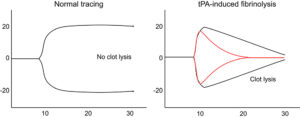A normal thromboelastographic (TEG) tracing is seen on the left, with no clot lysis occurring at 30 minutes after start of the assay. This is typical for normal dog blood, in which there is <7% lysis (93% of the clot remaining) at 30 minutes, regardless of addition of an activator or not. In contrast, when tPA is added to the sample, lysis is triggered and can be measured at 30 (shown in black tracing on right) or 60 minutes (not shown). The red tracing on the right shows a sample with increased fibrinolysis. In a bleeding dog, the latter tracing may point to excessive fibrinolysis as being a potential cause of hemorrhage. In such dogs, particularly if another cause of hemorrhage is not found, trial testing with a fibrinolytic inhibitor, such as epsilon aminocaproic acid, could be considered.

